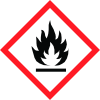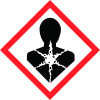3M 05917 Polyolefin Adhesion Promoter Aerosol
3m company
Revision date : 2018-08-17



Note: Ingredients listed on restricted chemical lists
EC/CAS
108-88-3
Name of the chemical
Toluene
Concentration
N/A
EC/CAS
203-625-9
Name of the chemical
Toluene
Concentration
N/A
General Information
Revision date
2018-08-17
Product name
3M 05917 Polyolefin Adhesion Promoter Aerosol
Emergency telephone
+44 (0)1344 858 000
Icons in SDS
Company Information
Company name
3m company
E-mail address of the competent person responsible for the Safety Data Sheet
tox.uk@mmm.com
GHS Information
Signal word
Danger
Hazard Codes
Hazard statements (CLP)
H222, H229, H304, H315, H319, H336, H361, H361d, H373, H412
Hazard statements
Code
Statements
H222
Extremely flammable aerosol
H229
Pressurized container: may burst if heated
H304
May be fatal if swallowed and enters airways
H315
Causes skin irritation
H319
Causes serious eye irritation
H336
May cause drowsiness or dizziness
H361
Suspected of damaging fertility or the unborn child
H361d
Suspected of damaging the unborn child
H373
May causes damage to organs through prolonged or repeated exposure
H412
Harmful to aquatic life with long lasting effects
Precautionary statements
Code
Statements
P211
Do not spray on an open flame or other ignition source.
P251
Do not pierce or burn, even after use.
P260
Do not breathe dust/fume/gas/mist/vapors/spray.
P410+P412
Protect from sunlight. Do not expose to temperatures exceeding 50 °C/122°F.
P501
Dispose of contents/container to ...
Section 2
2.1 Classification of the substance or mixture
CLP REGULATION (EC) No 1272/2008 Aerosol, Category 1 - Aerosol 1; H222, H229 Serious Eye Damage/Eye Irritation, Category 2 - Eye Irrit. 2; H319 Skin Corrosion/Irritation, Category 2 - Skin Irrit. 2; H315 Reproductive Toxicity, Category 2 - Repr. 2; H361 Specific Target Organ Toxicity-Single Exposure, Category 3 - STOT SE 3; H336 Specific Target Organ Toxicity-Repeated Exposure, Category 2 - STOT RE 2; H373 Hazardous to the Aquatic Environment (Chronic), Category 3 - Aquatic Chronic 3; H412 For full text of H phrases, see Section 16.
2.2 Label elements
CLP REGULATION (EC) No 1272/2008
Hazard pictograms
GHS02 (Flame) |GHS07 (Exclamation mark) | GHS08 (Health Hazard) | Ingredients: Ingredient CAS Nbr EC No. % by Wt Toluene 108-88-3 203-625-9 60 - 90
Hazard statements
H222 Extremely flammable aerosol. H229 Pressurised container. may burst if heated. H319 Causes serious eye irritation. H315 Causes skin irritation. H336 May cause drowsiness or dizziness. H361d Suspected of damaging the unborn child. H373 May cause damage to organs through prolonged or repeated exposure: nervous system | sensory organs | H412 Harmful to aquatic life with long lasting effects.
Prevention
P210A Keep away from heat, hot surfaces, sparks, open flames and other ignition sources. No smoking. P211 Do not spray on an open flame or other ignition source. P251 Do not pierce or burn, even after use. P260E Do not breathe vapour or spray.
Storage
P410 + P412 Protect from sunlight. Do not expose to temperatures exceeding 50C/122F.
Disposal
P501 Dispose of contents/container in accordance with applicable local/regional/national/international regulations. 2% of the mixture consists of components of unknown acute oral toxicity. 34% of the mixture consists of components of unknown acute dermal toxicity.
Contains
2% of components with unknown hazards to the aquatic environment Notes on labelling Updated per Regulation (EC) No. 648/2004 on detergents. H304 is not required on the label because the product is an aerosol. Ingredients required per 648/2004 (not required on industrial label) <5% Halogenated hydrocarbons
2.3 Other hazards
None known.

